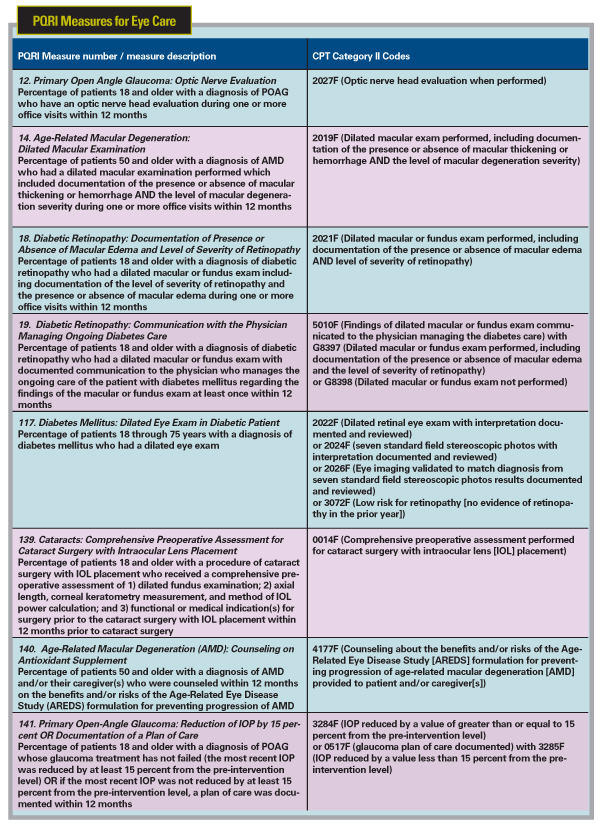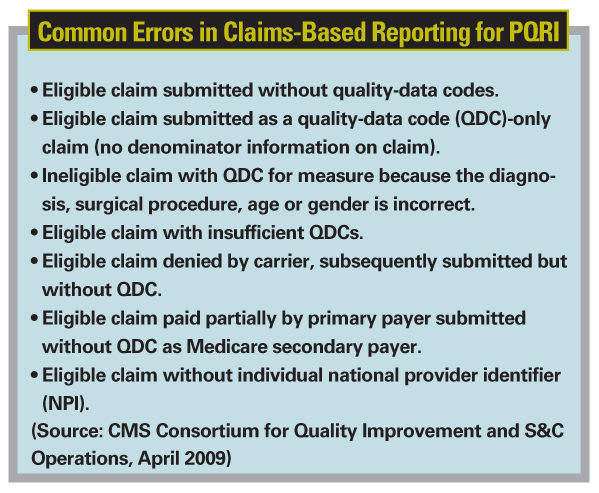Like many early adopters of Medicare's pay-for-performance program in 2007, ophthalmologist William Rich recalls the frustration of trying to submit outcomes data and then waiting for the bonuses that were supposed to follow. Dr. Rich, who conducts courses for colleagues on how to comply with the reporting standards, learned the student's frustration did not spare the teacher.
"Many of them did not get a bonus, and the reason has to do with the complexity of the system," explains Dr. Rich, a general ophthalmologist in
So the Centers for Medicare and Medicaid put together a panel to find out why so few physicians qualified for bonuses in 2007. "Many physicians who tried to participate and didn't get a bonus were very, very angry because of the annotated security measures," Dr. Rich recalls. "It was almost impossible to get at your reports to find out if you got a bonus and what you did wrong."
Such was the dubious nationwide debut of pay-for-performance, otherwise known as PFP or P4P. CMS is still playing catch-up. In the latter half of 2009, it expected to disburse thousands of bonuses—for the 2007 program. Among the paradigm shifts buffeting ophthalmology, P4P seems poised to leave a dramatically altered practice landscape in its wake.
What Is P4P?
In its purest form, P4P pays doctors and hospitals based on the quality of patient care they provide, and should emphasize results over costs. In theory it collects data from providers, compares it with all other providers' outcomes, then feeds that information back so they can see how they measure up. Many physicians, however, fear that P4P emphasizes costs over results.
Today PQRI is still voluntary, but the "Call to Action" whitepaper Sen. Max Baucus (D-Mont.) released in 2008 calls for extending incentives for physician participation and adding penalties for nonparticipation.1 "That is something that physicians' groups, including the MGMA [Medical Group Management Association], would all certainly oppose," says Robert Bennett, MGMA government affairs representative.
PQRI has established 153 performance measures for treatment outcomes, including eight specific to eye care (See Table). Besides PQRI, at least two other large scale P4P programs exist today: Bridges to Excellence (BTE), involving large employers and health plans in 13 different states; and Integrated Healthcare Association (IHA), a consortium of health plans that cover 12 million lives in
The upshot of P4P is to build a database of physician performance that physicians and patients alike can access. But PQRI, say many critics, focuses on reporting outcomes rather than improving them. CMS has ironed out many of the wrinkles that plagued the program the past two years, Mr. Bennett says. This year and next physicians can qualify for a 2-percent bonus on qualifying claims, but Medicare only has funding for the bonuses through 2010. This is on top of bonuses CMS offers for e-prescribing and electronic medical records.

The Ophthalmologist's Paradox
For ophthalmology, participating in P4P is not so straightforward. Reporting outcomes depends on having an EMR system compatible with CMS as well as private insurers, a function known as "interoperability." However, the body charged with developing those standards for ophthalmic EMR, the Commission for Healthcare Information Technology (CCHIT), may not complete ophthalmic standards until 2011.
Says Dr. Rich: "So if an ophthalmologist were to go and buy an EMR now in anticipation of getting a little bonus money in the future, I think that's fraught with hazard because number one, you don't know if it's going to meet the interoperability standards, and secondly and most importantly, there are no standards for ophthalmic EMR."
Despite that, ophthalmology was among the three specialties with the highest participation in PQRI, with more than 50 percent participation in its first six months, according to the AAO.
Hard Lessons of PQRI
The PQRI experience has made P4P a bitter pill for many physicians. For practices, reporting outcomes data was one thing, using that data to gauge practice performance quite another. "Conceivably you could have done everything properly in 2007 and not received your bonus check," says Mr. Bennett of the MGMA. The early problems with PQRI included:
• the 1500 claim forms for reporting quality codes "weren't designed for this use," Mr. Bennett says;
• even when claims reported the quality codes, Medicare contractors did not always collect and transmit that information to CMS;
• some filing instructions were misleading, as CMS admits; and
• accessing the 2007 PQRI Feedback Report was problematic, as 93 percent of physicians answering an MGMA said, requiring an average of eight hours of staff time to download the reports.
Also frustrating physicians is that PQRI is not the only P4P game out there. Physicians participating in various public and private programs encounter a lack of coordination and similarity. "Physicians and the back office staff that support them are quite frustrated with the different types of pay-for-performance plans, and there's always interest in harmonizing the different payers to at least have the same codes," Mr. Bennett says.
CMS and private insurers know they must overcome this obstacle before P4P becomes widely adopted. "The whole intent of the desire of the government, private insurers, and quality gurus like the Agency for Healthcare Policy and Research is to have one set of commonly approved measures and eliminate the duplicative nature," Dr. Rich says. "You're going to see less confusion for physicians in the future."

But Is It Better Medicine?
Published reports have questioned the clinical efficacy of P4P. Laura A. Petersen, MD, MPH, chief of health services research at Baylor College of Medicine in
"It's very interesting with a policy like this that has been so widely adopted, that there is so little evidence for its effectiveness or efficacy," she says. If she were to rank the evidence supporting P4P as if it were evidence-based medicine, she would give it "moderate at best."
She adds, "We have to understand whether pay for performance is a cost-effective intervention, and that has not been answered." Her team is currently conducting a large randomized control trial of P4P to evaluate its cost-effectiveness.
"So there's no validated data to show that adherence to PQRI leads to better outcomes, because the participation rate has not been high enough and the participation period has been short," adds Dr. Rich. "The whole goal is to raise that number from 50 to 95 percent." Achieving higher participation may be difficult. Even 10 years after clinical trials validate an evidence-based practice, only about 55 percent of physicians adopt it.
The Geisinger Experiment
Geisinger Health System in northeastern
Herbert J. Ingraham, MD, director of ophthalmology at Geisinger, explains that the cataract benchmarks were developed by a panel of Geisinger ophthalmologists, techs and nurses, drawing heavily upon guidelines from the AAO and American Society of Cataract and Refractive Surgeons. "To be honest, there was a dearth of material in the peer-reviewed literature that really looked at this in a very organized and very aggressive way," he says.
The cataract initiative, started about three years ago, involves six or seven surgeons in three centers. "The process has had a lot of value for us from an educational standpoint," Dr. Ingraham explains. That process draws heavily on the participating physicians using a uniformed documentation protocol and a common EMR, but no checklists.
The program has modestly achieved its goal. "It's actually been a net plus for the department because we built in a certain complication rate and so far, even though again it's not statistically significant, the complication rate is less," Dr. Ingraham says. "We were able to standardize our surgical trays and some of our equipment. We were more efficient because our turnover time was less and the operating room time was less."
Pitfalls of Outcomes Data
An integrated health system such as Geisinger can smooth over a lot of P4P obstacles that a small practice might otherwise encounter. As director of health policy and government relations at the National Medical Association, the medical society for African-American physicians, Byron Sogie-Thomas has pondered what P4P could mean for solo practitioners and small groups.
"If they're in a smaller group then it necessarily means a smaller patient load, which means they can collect less data, which also means usually that they have less personnel and less technology to help them collect this data because their revenue base is smaller," Mr. Sogie-Thomas says.
P4P data collection tends to skew favorably toward large practices and those with a relatively healthy patient base. "You could be a great doctor, but the results that you are showing, because your patients are sicker, means that your improvement is starting from a lower baseline than the healthier patient," Mr. Sogie-Thomas says.
Patient socioeconomic profile and compliance habits can also impact outcomes data. The Agency for Healthcare Research and Quality all but admitted this in a 2006 report: "Providers with highly educated patients traditionally experience better patient adherence and cooperation, which may affect their performance ratings."4 A small ophthalmology practice with a fair number of macular degeneration or glaucoma patients should take note.
P4P aims to put outcomes data in the public domain, so health consumers could be acting upon flawed data. "Everybody could gravitate toward the guy who's seeing healthier patients," Mr. Sogie-Thomas says. "The other guy who's not getting so good a score, who may in fact be a better physician, could be losing business." This dynamic could undermine the viability of small practices in rural areas and inner cities.
Personal Preparations for P4P
As the P4P front gathers, you can do a couple things to lessen its impact. Mr. Sogie-Thomas suggests the best move is to work through specialty societies such as the AAO and ASCRS to influence the National Quality Forum, the panel CMS relies on for outcomes measures. Dr. Rich is vice chair of the NQF's Health Professions Council.
At the MGMA, Mr. Bennett advises physicians to tap every available source—CMS, AAO and AMA among them. "Have someone in the office become familiar with the ins and outs of the program. Talk to another practice that maybe tried last year and learn from their mistakes," he says.
Next, Comparative Effectiveness
The next step in P4P is comparative effectiveness, which measures different treatment modalities against one another. For example, this could involve comparing implantation of a glaucoma drainage device with trabeculectomy to medical therapy for lowering intraocular pressure for glaucoma.
"As for the concept of comparative effectiveness, the boundaries are still somewhat under construction, but in general the emphasis has been on studies that either assess existing evidence on the best treatment options for a condition, or that develop new evidence via clinical trials or registries," Steven Pearson, MD, M Sc, president of the Institute for Clinical and Economic Review, told a Senate Committee last year.
Once established, those boundaries may set the parameters that redefine how you treat any ocular condition in the next decade.
1. Baucus M. Call To Action: Health Reform 2009. p 45. Available at: http://finance.senate.gov/healthreform2009/finalwhitepaper.pdf. Accessed June 5, 2009.
2. Rosenthal MB, Landon BE,
3. Petersen LA, Woodard LC, Urech T, Daw C, Sookanan S. Does pay-for-performance improve the quality of health care? Ann Intern Med 2006; 145:265-272
4. From AHRQ paper: "Pay for Performance: A Decision Guide for Purchasers. AHRQ Publication No. 06-0047 April 2006











